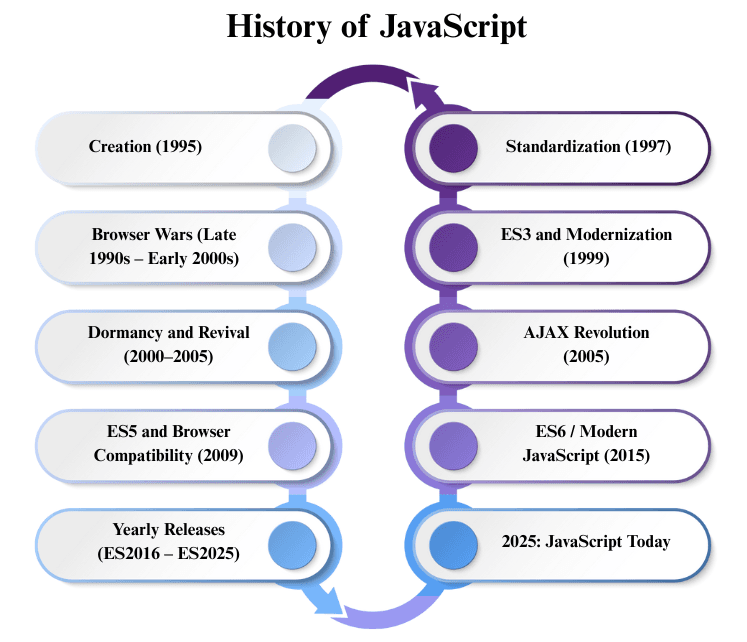History of JavaScript
JavaScript, one of the core technologies of the web, has a rich history that spans over two decades. It was created to make web pages interactive, evolving from a simple scripting language to a full-fledged programming language powering modern web applications.

1. Creation (1995)
- Developer: Brendan Eich at Netscape Communications.
- Original Name: Mocha → LiveScript → JavaScript.
- Purpose: Add interactivity to static HTML pages, such as form validation, simple animations, and dynamic content updates.
2. Standardization (1997)
- ECMAScript: JavaScript was standardized by ECMA International to ensure consistency across browsers.
- First Edition (ES1): Defined core language features like variables, loops, functions, and basic error handling.
3. Browser Wars (Late 1990s – Early 2000s)
- Microsoft introduced JScript for Internet Explorer.
- Netscape had JavaScript in Navigator.
- Problem: Different implementations caused compatibility issues between browsers.
4. ES3 and Modernization (1999)
- ECMAScript 3: Introduced regular expressions, better string handling, and robust error types (
TypeError,ReferenceError). - Significance: Laid the foundation for modern JavaScript error handling and programming patterns.
5. Dormancy and Revival (2000–2005)
- JavaScript remained relatively stagnant as browser competition slowed.
- Web developers increasingly used DHTML and plugins like Flash for interactivity.
6. AJAX Revolution (2005)
- Asynchronous JavaScript and XML (AJAX): Allowed web pages to update data without reloading.
- Impact: JavaScript became central to building dynamic, responsive web applications.
7. ES5 and Browser Compatibility (2009)
- Introduced strict mode, JSON support, getters/setters, and enhanced Array methods.
- Significance: Standardized behavior across browsers, reducing compatibility issues.
8. ES6 / Modern JavaScript (2015)
- Major language overhaul: let/const, arrow functions, classes, modules, promises, Map/Set, symbols.
- Impact: Made JavaScript suitable for large-scale application development.
9. Yearly Releases (ES2016 – ES2025)
- After ES6, ECMAScript adopted annual updates, introducing features like:
- Async/Await (ES2017) for cleaner async code.
- Promise.any, Optional chaining, BigInt (ES2020)
- Top-level await, Error.cause (ES2022)
- Impact: Keeps JavaScript modern, efficient, and developer-friendly.
10. JavaScript Today (ES2025)
- Runs in browsers, servers (Node.js), mobile apps, and IoT devices.
- Frameworks/Libraries: React, Angular, Vue, and many others leverage modern JavaScript features.
- Community: One of the largest programming communities with extensive tooling, documentation, and resources.

